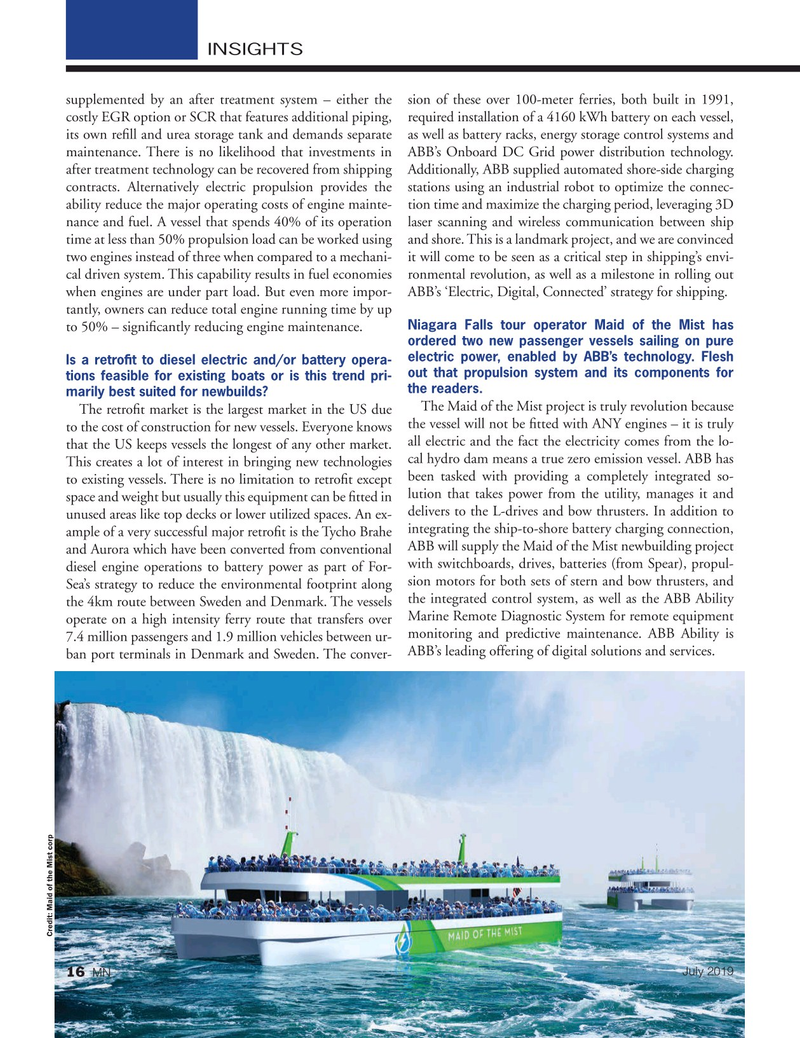
Page 16: of Marine News Magazine (July 2019)
Propulsion Technology
Read this page in Pdf, Flash or Html5 edition of July 2019 Marine News Magazine
INSIGHTS supplemented by an after treatment system – either the sion of these over 100-meter ferries, both built in 1991, costly EGR option or SCR that features additional piping, required installation of a 4160 kWh battery on each vessel, its own re? ll and urea storage tank and demands separate as well as battery racks, energy storage control systems and maintenance. There is no likelihood that investments in ABB’s Onboard DC Grid power distribution technology. after treatment technology can be recovered from shipping Additionally, ABB supplied automated shore-side charging contracts. Alternatively electric propulsion provides the stations using an industrial robot to optimize the connec- ability reduce the major operating costs of engine mainte- tion time and maximize the charging period, leveraging 3D nance and fuel. A vessel that spends 40% of its operation laser scanning and wireless communication between ship time at less than 50% propulsion load can be worked using and shore. This is a landmark project, and we are convinced two engines instead of three when compared to a mechani- it will come to be seen as a critical step in shipping’s envi- cal driven system. This capability results in fuel economies ronmental revolution, as well as a milestone in rolling out when engines are under part load. But even more impor- ABB’s ‘Electric, Digital, Connected’ strategy for shipping.
tantly, owners can reduce total engine running time by up
Niagara Falls tour operator Maid of the Mist has to 50% – signi? cantly reducing engine maintenance. ordered two new passenger vessels sailing on pure electric power, enabled by ABB’s technology. Flesh
Is a retro? t to diesel electric and/or battery opera- out that propulsion system and its components for tions feasible for existing boats or is this trend pri- the readers.
marily best suited for newbuilds?
The Maid of the Mist project is truly revolution because
The retro? t market is the largest market in the US due to the cost of construction for new vessels. Everyone knows the vessel will not be ? tted with ANY engines – it is truly that the US keeps vessels the longest of any other market. all electric and the fact the electricity comes from the lo-
This creates a lot of interest in bringing new technologies cal hydro dam means a true zero emission vessel. ABB has to existing vessels. There is no limitation to retro? t except been tasked with providing a completely integrated so- space and weight but usually this equipment can be ? tted in lution that takes power from the utility, manages it and delivers to the L-drives and bow thrusters. In addition to unused areas like top decks or lower utilized spaces. An ex- ample of a very successful major retro? t is the Tycho Brahe integrating the ship-to-shore battery charging connection, and Aurora which have been converted from conventional ABB will supply the Maid of the Mist newbuilding project with switchboards, drives, batteries (from Spear), propul- diesel engine operations to battery power as part of For-
Sea’s strategy to reduce the environmental footprint along sion motors for both sets of stern and bow thrusters, and the 4km route between Sweden and Denmark. The vessels the integrated control system, as well as the ABB Ability operate on a high intensity ferry route that transfers over Marine Remote Diagnostic System for remote equipment monitoring and predictive maintenance. ABB Ability is 7.4 million passengers and 1.9 million vehicles between ur-
ABB’s leading offering of digital solutions and services.
ban port terminals in Denmark and Sweden. The conver-
Credit: Maid of the Mist corp
July 2019 16 MN
MN July19 Layout 1-17.indd 16 6/20/2019 9:40:31 AM

 15
15

 17
17
